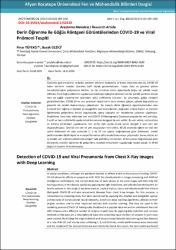| dc.contributor.author | Tüfekçi, Pınar | |
| dc.contributor.author | Gezici, Burak | |
| dc.date.accessioned | 2023-10-04T10:04:24Z | |
| dc.date.available | 2023-10-04T10:04:24Z | |
| dc.date.issued | 01.03.2023 | en_US |
| dc.identifier.citation | Tüfekçi, P. & Gezici, B. (2023). Derin Öğrenme ile Göğüs Röntgeni Görüntülerinden COVID-19 ve Viral Pnömoni Tespiti . Afyon Kocatepe Üniversitesi Fen Ve Mühendislik Bilimleri Dergisi , 23 (1) , 89-100 . DOI: 10.35414/akufemubid.1152432 | en_US |
| dc.identifier.uri | https://doi.org/10.35414/akufemubid.1152432 | |
| dc.identifier.uri | https://dergipark.org.tr/tr/download/article-file/2570075 | |
| dc.identifier.uri | https://hdl.handle.net/11630/11229 | |
| dc.description.abstract | Günümüz şartlarında her ne kadar pandemi etkilerini kaybetmiş ve bitme sürecinde olsa da, COVID-19
halen etkilerini insanlar üzerinde hafif olarak göstermektedir. Yapay Zeka ve görüntü işleme
teknolojilerindeki gelişmelerle birlikte, bu tür virüslerin erken aşamalarda doğru bir şekilde tespit
edilmesi, hem doğru tedavinin uygulanarak hastalığın iyileşme sürecine hızlı bir şekilde yardımcı olacak
hem de sağlık sistemlerinin üzerindeki yükü hafifletmiş olacaktır. Bu çalışmada, göğüs röntgeni
görüntülerinden, COVID-19 ve viral pnömoni hastalıklarını ayırt etmeye çalışan, yüksek doğruluklu ve
güvenilir bir model oluşturulmaya çalışılmıştır. Bu amaçla, derin öğrenme algoritmalarından olan
Evrişimli Sinir Ağlarının AlexNet ve GoogleNet özel mimarilerinin, doğrudan orijinal halleri ve transfer
öğrenmeyle geliştirilmiş halleri uygulanarak, geniş kapsamlı bir modelleme çalışması yapılmıştır.
Modelleme sürecinde, kullanılan veri seti (COVID-19 Radiography Database) popüler bir veri seti olup,
3 sınıflı ve her sınıfta farklı sayıda örnek bulunduran dengesiz bir veri setidir. Bu veri setine, veri azaltma
ve arttıma yöntemleri uygulanarak, her sınıfta eşit sayıda örnek içeren dengeli 2 yeni veri seti
oluşturulmuştur. Orijinal veri seti ve yeni oluşturulan veri setleri, 80-20 oranında eğitim ve test veri
setine bölünerek ve aynı zamanda 3, 5 ve 10 kez çapraz doğrulamaya göre bölünerek, model
performansları ölçülmüştür ve en iyi performansa sahip model bulunmaya çalışılmıştır. Sonuç olarak, en
iyi model, veri arttırma yöntemiyle dengeli hale getirilmiş veri setinin, 10 kez çapraz doğrulamaya göre
bölünerek, transfer öğrenme ile geliştirilmiş AlexNet mimarisinin uygulandığı model olarak, % 99.90
doğruluk başarısı ile bulunmuştur. | en_US |
| dc.description.abstract | In today's conditions, although the pandemic has lost its effects and is in the process of ending, COVID19 still shows its effects on people as mild. With the developments in image processing and Artificial
Intelligence technologies, the correct detection of such viruses in the early stages will both help the
healing process of the disease quickly by applying the right treatment, and will alleviate the burden on
health systems. In this study, it has been tried to create a high-accuracy and reliable model that tries to
distinguish COVID-19 and viral pneumonia diseases from chest X-ray images. For this purpose, a
comprehensive modeling study has been carried out by applying the AlexNet and GoogleNet special
architectures of convolutional neural networks, which are deep learning algorithms, directly to their
original versions and to their improved versions with transfer learning. The data set used in the
modeling process (COVID-19 Radiography Database) is a popular data set and an unbalanced data set
with 3 classes and a different number of samples in each class. By applying data reduction and increase
methods to this data set, 2 new balanced data sets containing equal number of samples in each class
were created. By dividing the original dataset and newly created datasets into training and test datasets
at a rate of 80-20, and also by cross validating 3, 5, and 10 times, model performances were measured
and the model with the best performance was tried to be found. As a result, the best model was found with 99.90% accuracy, as the data set balanced by data augmentation method was divided according
to cross validation 10 times and AlexNet architecture developed with transfer learning was applied | en_US |
| dc.language.iso | tur | en_US |
| dc.publisher | Afyon Kocatepe Üniversitesi | en_US |
| dc.identifier.doi | 10.35414/akufemubid.1152432 | en_US |
| dc.rights | info:eu-repo/semantics/openAccess | en_US |
| dc.subject | COVID-19 | en_US |
| dc.subject | Viral Pnömoni | en_US |
| dc.subject | Derin Öğrenme | en_US |
| dc.subject | AlexNet | en_US |
| dc.subject | GoogleNet | en_US |
| dc.subject | Viral Pneumonia | en_US |
| dc.subject | Deep Learning | en_US |
| dc.title | Derin öğrenme ile göğüs röntgeni görüntülerinden COVID-19 ve viral pnömoni tespiti | en_US |
| dc.title.alternative | Detection of COVID-19 and viral pneumonia from chest X-Ray images with deep learning | en_US |
| dc.type | article | en_US |
| dc.relation.journal | Afyon Kocatepe Üniversitesi Fen ve Mühendislik Bilimleri Dergisi | en_US |
| dc.department | Afyon Kocatepe Üniversitesi | en_US |
| dc.authorid | 0000-0003-4842-2635 | en_US |
| dc.authorid | 0000-0001-8976-0185 | en_US |
| dc.identifier.volume | 23 | en_US |
| dc.identifier.startpage | 89 | en_US |
| dc.identifier.endpage | 100 | en_US |
| dc.identifier.issue | 1 | en_US |
| dc.relation.publicationcategory | Makale - Ulusal Hakemli Dergi - Başka Kurum Yazarı | en_US |



















